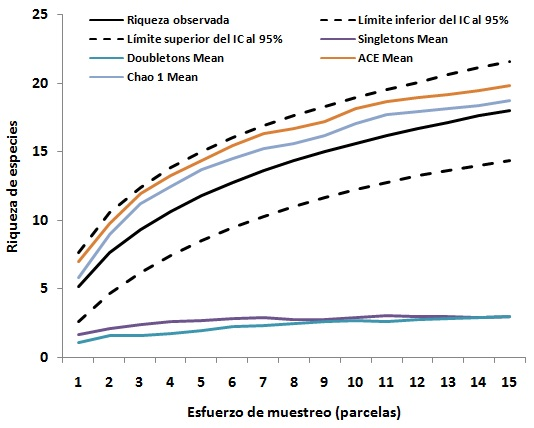Characterization of the structure of the Swamp Forest Zonal Conservation Unit "Cauto Sur"
Main Article Content
Abstract
The study was carried out in the Swamp Forest in the Zonal Conservation Unit "Cauto Sur", refuge of delta of Cauto fauna, with the objective of characterizing the vascular flora. A random sampling was carried out with 15 plots of 100 m², where all individuals with more than 7 cm of d1.30 were recorded. Sampling was validated with the method of the area-species and distance curve, in addition the parameters of the horizontal structure were determined: relative abundance, relative frequency and relative dominance, the diametric structure and the vertical structure were also studied. The diversity of the swamp forest was low, represented by 27 families, 40 genera, 40 species and 673 individuals, the most diverse families were Leguminosae and Combretaceae. According to the phytogeographic origin, 61 % of the flora were native species, 7 % of endemic species and 32 % of exotic species. The presence of the threatened category taxa Pictetia mucronata (Griseb.) Beyra & Lavin, Catesbaea gamboana Urb and Thespesia cubensis (Britton & P. Wilson) J.B. Hutch. The dominant arboreal stratum between 5 and 13 m high, was represented by latizales, which denoted the state of regeneration in which the forest is located. They were Bucida subinermis Bisse and Bursera simaruba (L.) Sarg, the best acclimated species to the site conditions of the Swamp forest.
Downloads
Article Details
References
BASCOPÉ, F Y JORGENSEN, P. Caracterización de un bosque montano húmedo: Yungas, La Paz. Ecología en Bolivia, 2005, 40(3), 365-379.
CANTOS, G. Caracterización estructural y propuesta de restauración del bosque nativo de la comuna el pital, zona de amortiguamiento del parque nacional Machalilla, Ecuador. [Tesis presentada en opción al grado científico de doctor en ciencias forestales]. Univ. De Pinar del Río, Cuba, 2013.
CAPOTE, P. Y BERAZAÍN, R. Clasificación de las formaciones vegetales de Cuba. Revista de Jardín Botánico Nacional, 1984, 5(2), 27–75.
CUEVAS, G.; LÓPEZ, M. Y.; y GARCÍA, M. Primer registro de Desmopsis trunciflora (Schlecht y Cham) G. E. Schatz (Annonaceae) para el occidente de México y análisis de su población en la Sierra de Manantlán, Jalisco. Acta Botánica Mexicana, 2002, (58), 7-18.
CURTIS, J Y MCINTOSH, R. The inter relation of certain analytic and syn-thetic phytosociological characters. Ecology, 1950, (31), 434-445.
FAO. [en línea]. 2002. [consultada el 2 de mayo del 2013]. Disponible en: www.fao.org/forestry/site/13087/es
GONZÁLEZ, T. et. al. Lista roja de la flora de Cuba. Bissea, 2016, 10(no. especial 1), 1-352.
HIGUCHI, P. et.al. Dinâmica da comunidade arbórea em um fragmento de floresta estacional semidecidual montana em Lavras, Minas Gerais, em diferentes classes de solos. Revista Árvore, 2008, 32(3), 417–426. [consultada el 2 de mayo del 2013]. Disponible en: http://web.catie.ac.cr/informacion/RFCA/rev34/pag66.pdf
JIMÉNEZ, V. y HORTAL, J. Las curvas de acumulación de especies y la necesidad de evaluar la calidad de los inventarios biológicos, revista ibérica de aracnología, Departamento de Biodiversidad y Biología Evolutiva (Entomología). Madrid, España: Museo Nacional de Ciencias Naturales (C.S.I.C.), 2003.
KEELS, S., GENTRY, A., y SPINZI, L. Using vegetation analysis to facilitatethe selection of conservation sites in eastern Paraguay. Washington: SI/MAB: (Biodiversity measuring and monitoring certification training, volume 2), 1997.
LABRADA, P. Plan de manejo “Delta del Cauto”. 2017-2021. 2017.
LAMPRECHT, H. Silvicultura en los Trópicos. Los ecosistemas forestales en los bosques tropicales y sus especies arbóreas – posibilidades y métodos para un aprovechamiento sostenido. República Federal de Alemania: Ed: Cooperación Técnica, 1990.
LOUMAN, B.; QUIRÓS, D. Y NILSSON, M. Silvicultura de bosques latifoliados tropicales con énfasis en América Central. Turrialba: CR, CATIE, 2001.
MELO, O. y VARGAS, R. Evaluación ecológica y silvicultural de ecosistemas boscosos. Crq, carder, corpocaldas, Cortolima: Universidad del Tolima, 2003. ISBN 956- 9243-03-07.
MORALES, S. Diversidad y estructura horizontalen los bosques tropicales del Corredor Biológico de Osa, Costa Rica. Revista Forestal Mesoamericana Kurú (Costa Rica), 2012, 9(23), 2215-2504.
MORENO, C. Métodos para medir la biodiversidad. Zaragosa, España: M & T-Manuales y Tesis SEA, 2001.
MOSTACEDO, B Y FREDERICKSEN, T. Manual de Métodos Básicos de Muestreo y Análisis en Ecología Vegetal. Santa Cruz de la Sierra. Bolivia: Proyecto de Manejo Forestal Sostenible (BOLFOR), 2000.
ORTIZ, E Y CARRERA, F. Estadística Básica para Inventarios Forestales. En: Orozco, L. y Brumer, C. Inventarios Forestales para Bosques Latifoliados en América Central, 2002, p.71 – 117.
PÉREZ, M. et.al. Composición y diversidad de los bosques de la Región Autónoma del Atlántico Norte de Nicaragua. Revista Forestal Centroamericana [en línea]. 2001, (34), 66–72. [Consultado 23 feb 2014]. Disponible en: http://web.catie.ac.cr/informacion/RFCA/rev34/pag66.pdf
REYES, O. Clasificación de la vegetación de la Región Oriental de Cuba. Revista del Jardín Botánico Nacional, 2012, 59(71), 32-33.
RUSCHEL, A. et.al. Caracterização e dinâmica de duas fases sucessionais em floresta secundária da Mata Atlântica. Revista Árvore, 2009, 33(1). 101 – 115.


